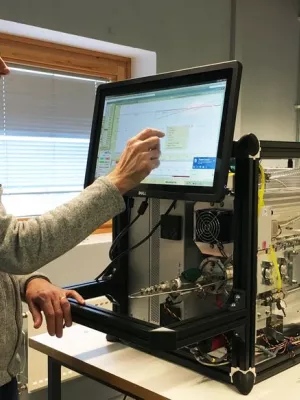
Erik Swietlicki
Professor

Deposition efficiency of inhaled particles (15-5000 nm) related to breathing pattern and lung function : An experimental study in healthy children and adults
Författare
Summary, in English
Background: Exposure to airborne particles has a major impact on global health. The probability of these particles to deposit in the respiratory tract during breathing is essential for their toxic effects. Observations have shown that there is a substantial variability in deposition between subjects, not only due to respiratory diseases, but also among individuals with healthy lungs. The factors determining this variability are, however, not fully understood. Method: In this study we experimentally investigate factors that determine individual differences in the respiratory tract depositions of inhaled particles for healthy subjects at relaxed breathing. The study covers particles of diameters 15-5000 nm and includes 67 subjects aged 7-70 years. A comprehensive examination of lung function was performed for all subjects. Principal component analyses and multiple regression analyses were used to explore the relationships between subject characteristics and particle deposition. Results: A large individual variability in respiratory tract deposition efficiency was found. Individuals with high deposition of a certain particle size generally had high deposition for all particles <3500 nm. The individual variability was explained by two factors: breathing pattern, and lung structural and functional properties. The most important predictors were found to be breathing frequency and anatomical airway dead space. We also present a linear regression model describing the deposition based on four variables: tidal volume, breathing frequency, anatomical dead space and resistance of the respiratory system (the latter measured with impulse oscillometry). Conclusions: To understand why some individuals are more susceptible to airborne particles we must understand, and take into account, the individual variability in the probability of particles to deposit in the respiratory tract by considering not only breathing patterns but also adequate measures of relevant structural and functional properties.
Avdelning/ar
- Ergonomi och aerosolteknologi
- NanoLund: Centre for Nanoscience
- Klinisk fysiologi och nuklearmedicin, Malmö
- Kärnfysik
- MERGE: ModElling the Regional and Global Earth system
Publiceringsår
2017-04-08
Språk
Engelska
Publikation/Tidskrift/Serie
Particle and Fibre Toxicology
Volym
14
Issue
1
Dokumenttyp
Artikel i tidskrift
Förlag
BioMed Central (BMC)
Ämne
- Respiratory Medicine and Allergy
Nyckelord
- Aerosols
- Airborne particles
- Airway dead space
- Individual variability
- Inhalation
- Lung dose
- NanoSafety
- Particle lung deposition
- Respiratory tract deposition
Status
Published
Forskningsgrupp
- Clinical Physiology and Nuclear Medicine, Malmö
ISBN/ISSN/Övrigt
- ISSN: 1743-8977